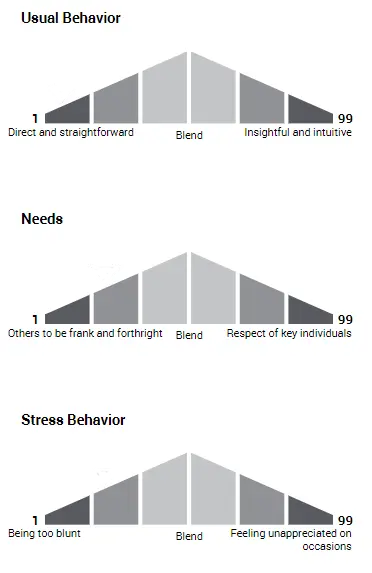In part 1 and part 2 of this 4-part series, we introduced The Birkman Method as a positive, social psychology assessment, discussed The Birkman Map, the importance of recognizing our top Interests, and glanced at the first three of our nine behavioral Components: Social Energy, Physical Energy, and Emotional Energy.
Tip: Before we dive in, please recall that the important thing to emphasize throughout the Components part of your Birkman conversation is that our biggest differentiator has always been our ability to describe people’s perceptions in a more profound way by measuring more than our outward, socialized self. The behavioral Components reveal our important root system: the underlying motivational Needs we all possess. The Components also show us when others may perceive differently and why this matters.
My father’s understanding of Needs is why Birkman has endured for 70 years. Even though this internal part of our personality is vital to who we are, it’s usually difficult for others to see. Even when we know someone really well, it helps the relationship when we can see and name our Needs in a non-judgmental way. I’ve known couples married for years, convinced they knew everything about their partner, yet found their partner’s Component’s Needs to be a revelation. Even more often, in the workplace, a once-annoying colleague can be seen in a whole new light. In addition, there is better stress management capability from knowing and articulating Needs because, while our underlying Needs may be invisible, our frustrated Stress behaviors are all too obvious.
Tip: All nine Components, Usual Behaviors, and Needs work in sync. They’re conjoined to make us who we are. A primary distinction of Birkman is our ability to show people how they can encompass both extraversion and introversion in so many ways throughout the nine Components. Importantly, whatever combination we happen to be, it’s natural and okay. The famous Swiss psychiatrist, Dr. Carl Jung, is reported to have said there’s no such thing as 100% extrovert or 100% introvert. Fact is, we boast fascinating and complex combinations of “both-and” when it comes to each behavioral Component and how they interact with one another.
Page 20:
Now that we’ve looked at the three Energy Components, let’s tackle the one that has always been the most difficult for us to name: Self-Consciousness. In my father’s earliest research, he called this a trait that measured levels of shyness before settling on the word Self-Consciousness. For many years, Self-Consciousness was called the Need for Esteem. Birkman has always chosen to use a single word that is equally positive across the spectrum, whether the number is high or low. When the numbers are very low, it is explained that the person is essentially free of feelings of shyness and tended to communicate easily in a candid, direct, and straightforward manner. At the very high end, the person is described as very sensitive to individual thoughts and feelings and worked hard to be tactful and diplomatic in their communication with others. Another way to describe high Self-Consciousness is how carefully a person self-monitors their speech and behaviors (“consciousness of self”) in the ways they chose to communicate and relate to others.

Clearly, there are strengths and advantages for every Component, whatever the numbers across the spectrum. We always find it easier to describe the very high and the very low extremes, despite the fact that the majority of us hover closest to the 40-60 range, which is not surprising since it represents the bell curve averages at the center of the spectrum.
Once again, no better or worse when it comes to Self-Consciousness, but the lower the number, the more we assume it’s easier for the person to be free of shyness and reserve. But here’s where it gets more interesting… while we see plenty of lower numbers in the Usual Behavior, a common pattern is to see the Needs showing a higher number. As we know, no better or worse, but this is the most often seen combination. Please refrain from thinking this means “they can dish it out but can’t take it.” I believe that the individual believes it’s better to behave in a straightforward way and be a direct communicator, AND they know others will be more sensitive and may get their feelings hurt. If this is working well for the person, it serves as an internal gauge that can serve them well.
Those who have described themselves as being on the high end, either for Usual and/or for Needs, consistently work hard at not coming across as too blunt or harsh in their communication. They worry about others’ feelings and strive to communicate in a diplomatic and respectful way. They seek to be supremely diplomatic. The danger for them is that if they are too careful, their tactful message may not be heard—what they meant as an order may sound more like a suggestion(!) In every scoring combination, it’s important to remember there’s always an upside to the trait and a possible downside.
Tip: Stress - Always remind your dialogue partner that the Stress behaviors they see on the page are not a given or a constant. What we term Stress is conditional and situational. It tends to be cumulative in nature, so it will show up more intensely when adverse conditions persist.
For many of us, the global pandemic of 2020, as it stretched out month after month, brought vivid reminders of what our own Stress behaviors feel like. Most of the time, when I see people read their Stress bullets, they nod and agree. However, if your conversation partner flinches and pushes back on their scores, it’s okay. Reassure them as many times as necessary that Stress scores are a warning meant to remind us of our need for self-care.
Page 21:
Assertiveness is a measure of our levels of comfort with verbal dominance. In fact, its original name was Dominance. It is simply a measure of how forcefully we like to communicate with others and our comfort level with asserting our views and opinions. It can help to ask your dialogue partner how they deal with someone who is opposite to them. If they have a directive style, how do they communicate with someone with a suggestive style, and vice-versa. We associate high Assertiveness with more of a military-style. In fact, this is absolutely necessary for careers that involve life and death circumstances, such as Emergency Medical Services, firefighters, police, etc.
As with every Component, some pluses and minuses accompany any place we land on the 1 to 99% spectrum. These are laid out for us quite clearly in the report, so let’s move on to the next page.
Page 22:
I like to refer to Assertiveness and Insistence as “the enforcement sisters.” Those of us who are high in Assertiveness are comfortable with command, and those who are high in Insistence are comfortable enforcing by control. Those who are high on both are truly seen as command and control. Once again, the strengths of highs and lows are easy to see on the Signature Report libraries, so let’s look at Incentives.
Page 23:
Incentives measure our preference for idealism or realism. Not surprisingly, a frequently seen pattern is to see a lower Usual coupled with a higher Need. When I see this, my comment to my partner is generally around the idea that you like to see a “win-win” where we can all win together. It is relatively rare to see a super high Usual here, but those who have it are highly motivated by knowing “what’s in it for me”? I describe the Incentive spectrum as spanning the Peace Corps mentality at the very lowest end and Wall Street ambition (zero-sum game) when the high hits 99. And as with all nine Components, both extremes have their place and can be just fine when under control.

In part 4, the final blog of this series, we’ll look at the last two Components of the Birkman Signature Report and the Career Exploration portion.

